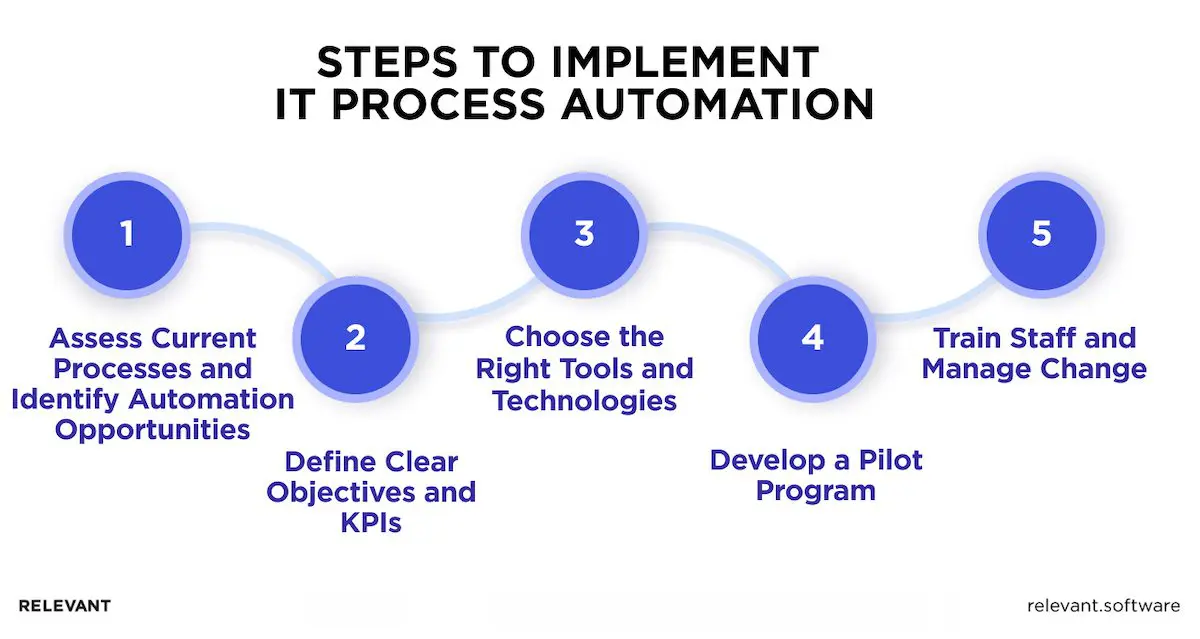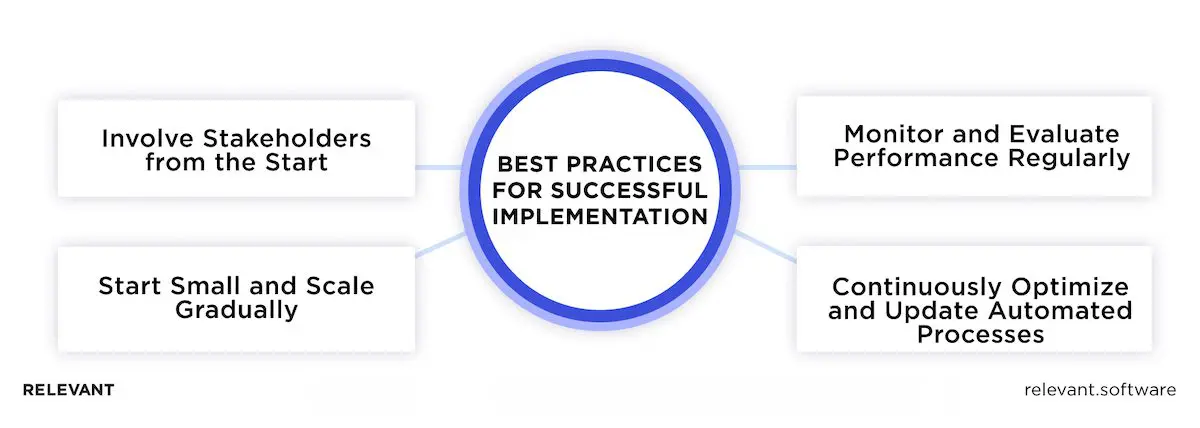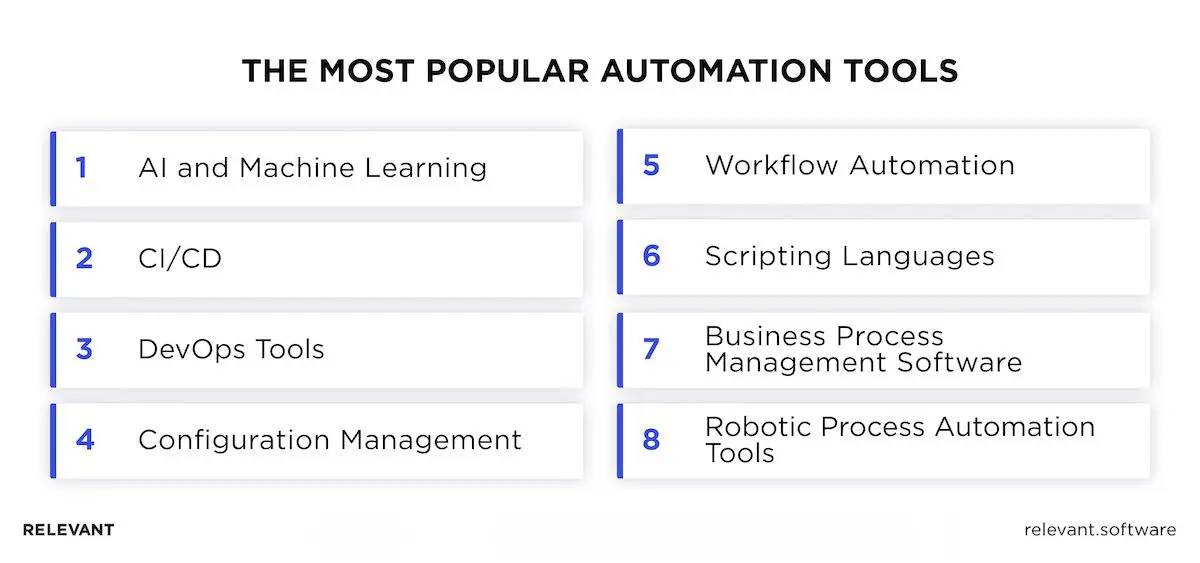The Essentials of IT Process Automation

IT process automation often gets a mixed reaction in the tech world. Some worry about complex processes or user resistance, thinking, “Our team can’t even troubleshoot basic tech issues; how will they handle automation?” Sound familiar?
While these concerns have a basis, they miss the broader picture. Yes, IT processes can be complex, but that doesn’t mean they can’t be automated. In reality, structured workflows can break down these complexities.
For CIOs, IT Process Automation (ITPA) goes beyond just keeping pace with technology. It’s a chance to align IT strategies with broader business goals and shift the IT department from a mere support function to a strategic powerhouse. Sure, it involves effort to begin with, but the lasting improvements in efficiency, savings, and innovation make it all worthwhile.
Did you consider RPA services for your business? Or just want to understand it better? In any event, this article offers expert insights to guide you through.
What is IT Process Automation?
To appreciate the advantages of IT operations automation, we must first understand what IT processes are and why they require automation. In IT, a typical day involves a multitude of tasks like:
- Respond to service requests
- Manage and monitor hardware and software
- Implement new technologies and troubleshoot issues
- Ensure compliance and security
- Perform regular maintenance and more
Just thinking about all these tasks can feel overwhelming. McKinsey reports that at two financial service companies, they discovered that 90% of IT teams spend their time on low-value tasks such as testing, deployment, and maintenance. In contrast, only 10% of their efforts are directed towards business priorities and work that sets them apart in the market.
That’s where IT process automation software steps in to save the day.
IT Process Automation (ITPA), or infrastructure automation, uses software to improve less-than-optimal processes and systems. This strategy aims to clear bottlenecks, cut down on errors and data loss, and enhance transparency and communication across departments. With an ITPA product, you can integrate multiple systems, applications, and platforms, which results in a more consistent and efficient IT setup.
Here, you may be faced with a choice between сustom vs. off-the-shelf IT automation solutions. Adapted to your unique business needs, custom automation solutions integrate seamlessly with your current systems. They offer the flexibility to adapt and grow as your business evolves, being ready for necessary modifications and enhancements over time.
Conversely, if your business processes are standard and don’t require extensive customization, off-the-shelf tools provide a practical and economical choice. Also we have options like a hybrid approach. It combines off-the-shelf tools for standard processes and custom modules for unique or complex requirements.
Hybrid solutions offer the flexibility of custom builds with the cost-effectiveness and quick deployment of off-the-shelf tools. This approach is ideal for businesses with diverse needs, as it optimizes their automation strategy without loss of functionality or efficiency.
BPA and RPA
Two key forms of automation are closely tied to IT process automation. They are:
Robotic Process Automation (RPA)
With RPA services, the software takes over specific repetitive tasks that people used to handle, such as data transfer between systems. RPA solutions are usually pre-built and easy to install, designed to operate on top of existing infrastructure without direct interaction with databases or application programming interfaces (APIs).
Business Process Automation (BPA)
BPA is closely related to IT process automation and can be considered a subset of it. It uses software to automate complex business transactions and activities that involve multiple steps and systems. Each BPA solution is tailored to an enterprise’s specific needs, integrated into its available data systems, and often connected via APIs. In many cases, BPA solutions incorporate RPA software to handle specific tasks within the broader automated workflow.
Common Misconceptions About IT Process Automation
We will expose the misconceptions below so you can better understand the true potential of IT process automation.
Automation will replace all jobs
In reality, automation shifts the nature of work rather than erases it. By taking care of repetitive and mundane tasks, automation frees up employees to focus on strategic and creative activities that require human insight and problem-solving skills. Companies that often leverage automation see enhanced productivity and innovation, which lead to new job roles and opportunities for professional growth.
IT process automation is just for large enterprises
It’s a myth that IT process automation only suits large enterprises with extensive resources. The truth is that businesses of all sizes can benefit. Scalable and customizable solutions make automation accessible to small and medium-sized enterprises (SMEs) as well.
It’s too complex and costly to implement
Modern automation tools are increasingly user-friendly and affordable. The return on investment (ROI) becomes evident through improved efficiency, reduced errors, and faster turnaround times. Companies can start small, automate simple tasks first, and then scale up as they experience the benefits.
Benefits of IT Process Automation
The IT process automation market, valued at $13.96 billion today, is set to grow to $51.26 billion by 2032 at a 13.89% CAGR. This growth shows the significant role of IT process automation software and its rising adoption across various industries.
But what is IT automation in terms of your profits? Here’s a table of how day-to-day IT task automation can benefit your business:
| Benefit | Description | Example |
| Lower Costs | Automation cuts IT costs because it reduces delays and errors and optimizes resources. | Automated invoice processing speeds up payment cycles and reduces staffing needs. |
| Enhanced Productivity | Employees can focus on higher-value tasks instead of repetitive activities. | Automated data entry makes financial reporting faster and more accurate. |
| Faster Problem Resolution | Automated systems quickly detect and respond to issues. | Automated security incident responses ensure immediate action on detected threats. |
| Better Accuracy | Ensures tasks are done correctly by adhering to set rules, which eliminates human error. | Automated data entry removes errors from financial records. |
| Improved Transparency | Gives a clear visibility into process performance and status. | Real-time monitoring and reporting tools help managers track progress and identify bottlenecks promptly. |
| Better Compliance | Ensures adherence to regulatory requirements and internal policies. | Automated processes comply with legal and regulatory standards, which reduces the risk of non-compliance. |
| Focus on Strategy | Frees up IT teams to work on innovation and strategic projects that drive business success. | Automated routine tasks give more time for research and development. |
Essential Criteria for Process Automation
To fully appreciate IT operations automation, we must first determine which IT processes are suitable for automation.
High Volume of Repetitive Tasks
When you think about automation, target processes with many repetitive tasks that often take time and resources but don’t add much strategic value. Automating them allows employees to focus on more important and creative work, which enhances productivity and job satisfaction. For example, automated data entry or routine maintenance tasks can drastically reduce the time spent on these activities and minimize human error.
Rule-Based Processes
Processes that follow strict, rule-based guidelines do not require human judgment or decision-making, which makes them perfect for automated systems. By automating rule-based processes, businesses ensure consistency and accuracy, as computerized systems strictly adhere to predefined rules. For example, in invoice processing, the system follows set rules to match purchase orders with invoices, flag discrepancies, and process payments.
Processes with High Error Rates
Tasks prone to human error should be high on the list for automation. Human errors can lead to costly mistakes, inefficiencies, and potential compliance issues. Automating these processes reduces these risks and leads to more reliable and accurate outcomes. For instance, automated financial reconciliations can ensure accuracy and compliance, as the system can handle complex calculations and data comparisons without the risk of human mistakes.
Time-Consuming Tasks that Delay Operations
Identify tasks that take up a lot of time and cause operations delays. These are also candidates for automation, as streamlined processes can significantly speed up overall operations. Additionally, labor-intensive tasks, such as report generation or manual data aggregation, can be automated to provide faster results, which allows for quicker decision-making and more agile business responses.
Steps to Implement IT Process Automation
Embarking on IT process automation can seem daunting, but with the right approach, it becomes manageable. Follow these expert steps to integrate automation into your IT framework seamlessly.

Assess Current Processes and Identify Automation Opportunities
Firstly, you need to evaluate your current IT processes. Identify which processes would benefit most from automation. This initial assessment helps pinpoint areas where automation can deliver the greatest impact, improve efficiency, and reduce costs.
Define Clear Objectives and KPIs
Establish clear objectives for what you want to achieve with automation. Whether it’s a reduction in processing time, a decrease in error rates, or an increase in productivity, having defined goals will guide your implementation. Set Key Performance Indicators (KPIs) to measure the success of the automation efforts.
Choose the Right Tools and Technologies
The proper tools and technologies are critical for automation success. Consider solutions that integrate well with your available systems and meet your specific needs. Evaluate options based on how scalable, user-friendly, and supported they are.
Develop a Pilot Program
Before you fully roll out automation, start with a pilot program. Choose a specific process or a small set of processes to automate first. This allows you to test the selected tools and technologies, identify potential issues, and make necessary adjustments. A pilot program provides valuable insights and helps build confidence in the automation initiative.
Train Staff and Manage Change
For automation to succeed, you need not only the right technology but also your team’s buy-in and support. Make sure to train your staff on the new automated processes and tools. Address any concerns and provide continuous support to ensure a smooth transition. Effective change management involves clear communication, training, and support to help employees adapt and thrive in an automated environment.
By following these steps, your organization can effectively implement IT process automation.
c Successful Implementation
A successful IT automation software rollout involves specific best practices. Here are a few tips to help you get it right from the start:

1. Involve Stakeholders from the Start: Engage key stakeholders early to ensure their input and buy-in. Their insights can shape the automation strategy and address any concerns upfront. By involving them from the start, you align the automation project with the organization’s goals and foster a sense of ownership and support.
2. Start Small and Scale Gradually: Begin with a small, manageable project to test the effectiveness of automation. Choose a simple process that can show quick wins. This approach lets you identify any issues and refine the process before scaling up. Gradually expand the scope of automation to mitigate risks and build confidence within the organization.
3. Monitor and Evaluate Performance Regularly: Set clear metrics to measure the success of your automated processes. Regularly monitor these metrics to assess performance and find areas for improvement.
4. Continuously Optimize and Update Automated Processes: Automation requires ongoing review and optimization to remain effective. As business needs and technologies evolve, so should your automated processes. Regularly update and refine the workflows to incorporate new advancements and address changeable requirements. This continuous improvement ensures that your automation efforts stay relevant and provide maximum value.
Challenges and Solutions in IT Process Automation
Transforming business operations through IT process automation software is impactful, but it does come with challenges. To fully benefit from automation, these challenges must be addressed head-on.

1. Integration with Current Systems: Integration of the new automation tools with available IT systems often poses a significant challenge. Legacy systems may not easily interface with modern automation technologies, which can cause compatibility issues and disrupt workflows.
Solution: Opt for automation tools that offer flexible integration capabilities, such as API support and middleware solutions. Conduct a thorough assessment of existing systems to identify potential integration points and challenges. Collaborate with vendors who provide robust integration support and tailor solutions to fit your specific infrastructure.
2. Managing Change and Resistance from Employees: Employee resistance is a common hurdle in IT process automation. Fear of job displacement and discomfort with new technologies can lead to pushback from staff.
Solution: Foster a culture of transparency and communication. Articulate how automation will enhance their roles rather than replace them. Offer thorough training and support to help them adapt. Involve employees early in the planning process to gather their input and address concerns, which fosters a sense of ownership and teamwork.
3. Ensuring Data Security and Compliance: Automation can introduce risks related to data security and regulatory compliance. You need to ensure that automated processes adhere to stringent security standards and comply with relevant regulations is critical.
Solution: Implement robust security measures, such as encryption, access controls, and regular audits, to protect sensitive data. Try to select automation tools that comply with industry standards and keep up with compliance changes. Conduct frequent security assessments and updates to manage risks and ensure compliance.
Overview of Popular Automation Tools
Curious about which automation tools can elevate your IT processes? This overview will introduce you to the most popular IT process automation tools, and highlight their key features and benefits.

1. AI and Machine Learning
AI and machine learning are crucial in IT process automation, enabling seamless workflows that enhance efficiency and accuracy. Key AI and ML tools include:
- TensorFlow: An open-source ML framework that offers a comprehensive ecosystem for the creation and deployment of anomaly detection algorithms, predictive models, and other ML-driven solutions.
- PyTorch: Known for its dynamic computational graph, this tool makes custom model building straightforward and automation in IT smooth.
- Scikit-learn: A popular Python library, highly useful for feature engineering, data analysis, and model training in automation in IT.
2. CI/CD (Continuous Integration and Continuous Deployment)
CI/CD tools implementation to automate software development and deployment ensures that code changes are both rapid and dependable. Popular CI/CD tools include:
- Jenkins: Widely used to build, test, and deploy applications, Jenkins automates software deliveries and code compilations.
- GitLab CI/CD: Part of the GitLab platform, it offers native CI/CD capabilities that simplify the definition and automation of CI/CD pipelines.
- Travis CI: Integrates seamlessly with GitHub, which allows IT teams to define build and deployment workflows through configuration files.
3. DevOps Tools
DevOps technologies are pivotal for automation and streamlining IT processes because they foster collaboration and efficient software delivery. Key IT process automation tools in such a case include:
- Docker: Enables easy automation of application deployment and scales by packaging applications and dependencies into containers.
- Kubernetes: Automates complex microservices architectures, ensuring resilience and availability through self-healing, service discovery, and load-balancing features.
- Terraform: An infrastructure as code (IaC) tool that enables automated scale, provision, and management of cloud resources.
4. Configuration Management
These tools automate the setup, configuration, and management of applications and systems and include:
- Puppet: Automates IT infrastructure management, handling services, files, packages, and user accounts.
- Chef: Uses code to describe desired configurations and automates IT tasks like configuration file management and application deployment.
- SaltStack: Excels in remote orchestration and execution and and offers scalability and speed for the management of large IT environments.
5. Workflow Automation
Workflow automation in IT implies the creation and automation of workflows through visual process representations. Common tools include:
- ServiceNow: A cloud-based platform for business process automation, handling complex tasks like change management and service request fulfillment.
- Zapier: Connects and automates workflows between web applications, often used for IT tasks like data transfer and system updates.
- Microsoft Power Automate: It automates workflows that connect multiple applications, manages data flows, and triggers event-based actions.
6. Scripting Languages
Scripting languages are vital for an IT process automation solution because they enable the automation of various tasks. Key languages include:
- Python: Versatile and widely used for writing automation scripts and tools, it leverages a vast ecosystem of third-party packages.
- Bash: Popular in Unix-like systems, Bash facilitates task automation, file management, and OS interactions.
- PowerShell: Primarily used in Windows environments, PowerShell automates system configuration, administration, and management tasks.
7. Business Process Management (BPM) Software
BPM software focuses on optimizing and automating entire business processes. These tools help design, model, execute, monitor, and refine business workflows across departments. The best BPM solutions include:
- Appian: Known for its low-code platform, it enables rapid development and automation of business processes.
- Pegasystems: Offers robust BPM capabilities for automating complex, multi-step workflows.
- Nintex: Provides tools for process mapping, workflow automation, and real-time analytics to streamline operations.
8. Robotic Process Automation (RPA) Tools
These tools mimic human actions by interacting with digital systems. Popular RPA tools for an IT process automation solution include:
- UiPath: Offers comprehensive automation capabilities with a focus on ease of use and scalability.
- Blue Prism: Known for its robust security and governance features, ideal for enterprise-grade automation.
- Automation Anywhere: Provides powerful RPA tools that integrate well with existing systems, which enhance efficiency and accuracy.

Emerging Technologies in Automation
Automation technology advances at lightning speed. Let’s explore these advancements and see how they can benefit your business.
Hyperautomation
It uses advanced technologies to automate as many business processes as possible. This approach outperforms traditional automation by integrating machine learning, artificial intelligence, and robotic process automation. Hyperautomation aims to create an environment where automated processes can learn, adapt, and evolve, which drives efficiency and innovation across the entire organization.
Intelligent Process Automation (IPA)
With Intelligent Process Automation (IPA), we see the next leap in automation. This technology merges robotic process automation with artificial intelligence, which enables it to handle complex tasks that require careful decision-making and detailed analysis. Unlike basic automation, which focuses on repetitive tasks, IPA uses AI to understand and process natural language, recognize patterns, and make informed decisions. This technology improves operational efficiency by not just automating tasks but also by optimizing and improving processes based on real-time data and insights.
Integration of AI and IoT
IoT devices collect vast amounts of data from various sources, while AI processes and analyzes this data to enable smarter decision-making. Through this synergy, predictive maintenance, real-time monitoring, and operational efficiency become possible. In manufacturing, IoT sensors can assess equipment performance, while AI can predict when maintenance is required, thus preventing costly downtime. This integration creates a more responsive and adaptive automation environment, which leads to better resource management and optimized processes.
Automating IT Processes with Relevant
While some companies still doubt the feasibility of automating IT, technological advancements have proven otherwise. IT process automation is not only possible but highly beneficial, and the sooner it’s implemented, the greater the advantages.
If you’ve learned enough to get started, there’s only one step left – choosing a provider. Trusted by fast-scaling startups and Fortune 500 companies, Relevant can be such a partner for IT automatization. Contact us today to leverage our deep IT expertise and receive product development services that are fully fitted to your business objectives.



